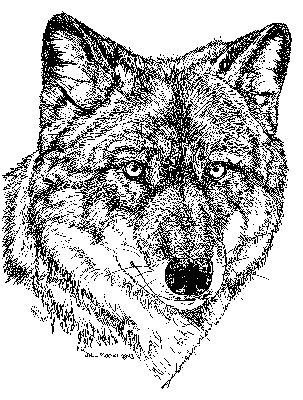
The Michigan Gray Wolf Recovery Management Plan is still in the office of Michigan Department of Natural Resources (DNR) Director K.L Cool. It will there be either approved or sent back to the "wolf team" with suggestions for changes. The wolf team is comprised of federal and state specialists, as well as individuals representing Native American interests.
Jim Hammill of the Michigan DNR said that it is hoped that the plan will come before the DNR meeting in October in the Upper Peninsula, where action should be taken on the plan, barring any unusual public comment. It is expected that the plan will pass, especially considering that there are fewer agricultural issues to deal with in Michigan than in Minnesota and Wisconsin. Thus the common politico-economic "charge" of public discussion on wolf recovery should be lessened to a degree.
Following are highlights of the impending Michigan Gray Wolf Recovery Management Plan as it exists now:
State officials say that pressure from the public is strongly in favor of protecting the wolf. With
regard to the compensation of farmers for losses suffered from wolves, private funds are
customarily established at first.

As for talk of a recommendation by the U.S. Fish and Wildlife Department to prepare to downgrade the species to "threatened" status, Hammill said that he has not heard of any such effort yet for Michigan. A "threatened" status would allow limited trapping and hunting of wolves. However, in any case, the lengthy re-classification process requires that a notice must first be published and that must be followed by public discussion. (see article p. 27) From the perspective of the government, considering the health of Michigan's wolf population growth, leaving a species on the list when it has "no biological grounds for being there" can ironically harm the integrity of the Endangered Species Act itself.
Although many are grateful for the return of the wolf, some also point out that the process might
be moving ahead a little too quickly. Wolves are just beginning to interact with people in
Michigan and an attempt to find a way to control their population is already underway. But
realistically, a balance between the two is the usual action today in any situation where wildlife has
to compete with an expanding human population. The fact that the wolves have made a
comeback and that public support is strong speaks volumes. Many simply propose that despite
the occasional setbacks, if educating the public has worked up to this point, there is no
overwhelming reason that it will not continue to work.

In terms of comparative recovery, Michigan is contrasted to both the Yellowstone and New Mexico reintroduction efforts, which drew national and worldwide attention in some cases. The return of the Michigan wolf population was more subtle and not really publicized until now. It was also a natural process much more than with the above two examples.
But there is no question that recovery has obviously been successful. Only three animals existed nine years ago in a remote area of the Upper Peninsula. Currently, biologists estimate Michigan's wolf population can be as high as 160, but it officially remains at 136, including the 24 wolves which reside on Isle Royale in a closed environment. The Upper Peninsula's wolves are spread out into 37 distinct packs which span all of the Upper Peninsula. Both critics and proponents have agreed that the wolf has reached a critical population point. A plan would be accepted by all.
The proposed state plan however, still has not addressed the issue of a population cap. When will recovery in Michigan be complete? Some biologists believe there is actually enough room in the Upper Peninsula for 500 to 1,000 animals. As an endangered species, the wolf has exhibited a surprising resilience despite its tainted image.
Critics of the wolf's inevitable migration to the Lower Peninsula echo the same perennial issues wolves have faced everywhere. Some express that it will just be a matter of time before livestock, pets and even children will ultimately fall prey. These critics are quick to cite Minnesota as example, where the wolf has destroyed both livestock and pets. As in other states, the majority in Michigan, including proponents, agree that marauding wolves will either need to be removed or destroyed.
Some hunters, not necessarily opposed to the wolf's expanding population, have pointed out that there is a danger to not see the wolf as a predatory killing machine. Of course, this is still an extreme depiction of the animal. Some of the strongest support in favor of the wolf has in fact come from hunters and fisherman; once more, a testament of the effectiveness of educating the public about the wolf's place in the wilderness.
In Michigan, the extensive white-tailed deer population accounts for up to half of the population's diet, each wolf eating approx 17-20 deer a year. Beaver, snowshoe hares, moles, mice and woodchucks comprise the remainder of their diet.
It is reprinted from the Summer 1997 Issue of WOLF! Magazine. This unique and comprehensive magazine is not supported by advertising, but by subscriptions. Please help keep this much needed resource alive!
 |